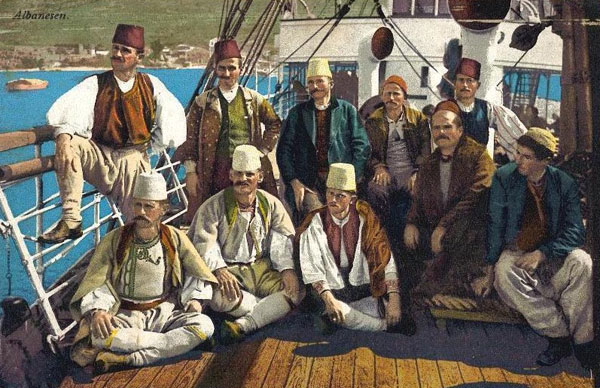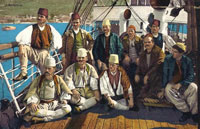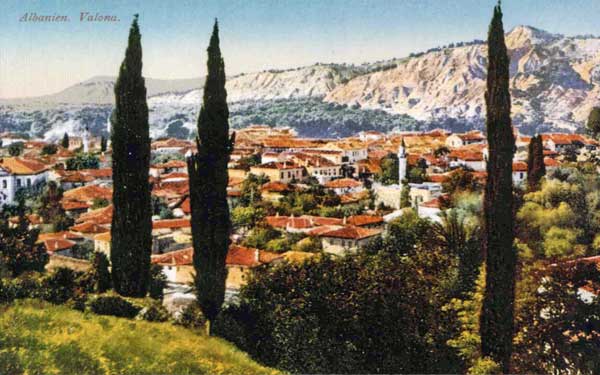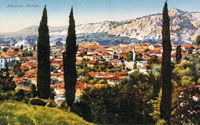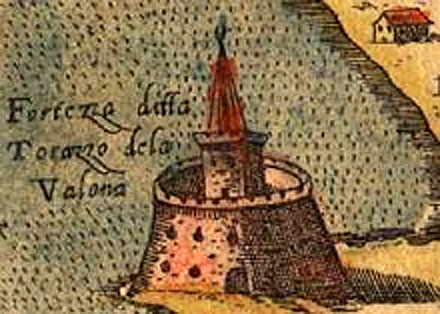| | Robert Elsie | AL Art | AL History | AL Language | AL Literature | AL Photography | Contact | |
Robert Elsie
Texts and Documents of Albanian History
BACK | AL History
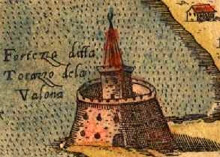
Vlora in 1573.
1579
Jean Carlier de Pinon:
Pirates in Vlora
Jean Carlier de Pinon was a French squire who lived in Paris and Cambray. He is the author of the work “Mon voyaige en Levant, faict l’an 1579” (My Voyage to the Levant, made in 1579). In it, he gives an account to his trip to the Holy Land with his German companion Hans Jacob Breuning from February 1579 to March 1580. Sailing from Venice to Constantinople and Alexandria, they stopped in the Ottoman port of Vlora, which he describes in the following extract.
On the 11th [May 1579], we sailed with a favourable wind, seeing nothing but sea and sky until, in the evening on the left side, we began to distinguish the mountains of Albania, formerly known as Epirus.
On the 12th, having advanced somewhat, we viewed the mountain across from Vallona [Vlora] and the mountain of Chimera [Himara] that is beyond Vlora.
On the 13th, having approached to four miles to the continent of Albania, where Vlora is situated, with the bonazza blowing behind us, we cast anchor after dinner. There, a Turk [Muslim], native of that region, disembarked on a frigate or small bark, and with him were some Greeks [Orthodox] endeavouring to get to Vlora that was not more than two or three miles away by land. They were going to Vlora to get some barks to unload goods they wished to leave in Vlora. Leading them was the ship scribe and the owner with four infantrymen or sailors. But when the frigate was no more than two miles from the ship, a fusta suddenly appeared before it, which had been lying in wait behind some rocks. We fired several cannons at it but were unable to hit it. We did not move from the spot all day where the owner had decided to drop anchor, and waited for the return of our frigate, but when it did not return by the end of the day, we suspected that something had happened to it.
On the 14th of May, in order to find out what had happened to the frigate, having raised anchor, we entered the port of Vlora. At the entrance of the said port from the northwest, there is a mountain or rock in the form of an island called Saseno [Sazan]. Having lowered our sails, we fired our cannons several times, which is the usual custom observed for entering ports. At that moment, the Emin or customs chief came out, accompanied by several other Muslims and Jews with whom talks were held on a carpet laid out for them in accordance with their customs. We were informed of what had happened to those who had gone to land the day before. They noticed the fusta pursuing them and swiftly hid the frigate among some bushes to save it. Having taken fright on realizing that they would most certainly be captured on land on their way to Vlora, the men abandoned this road and took the mountain path to the left, keeping more than twenty miles ahead of the thieves. At a certain place there was a little river and while they were there, exhausted as they were, they stirred up the water so that, when the thieves arrived, they would think they had crossed the said stream and would follow them over it. As they were very tired, they procured the assistance of a shepherd to escort them to a safe place, turned back along the road, and climbed the mountain on the right side where there was a village. When they got there, they found shelter in the home of a local Muslim, because custom has it in Turkey that one may not extract anyone from the home of a Muslim by force. The pirates, hearing that the shepherd had conducted them there, arrived at the said village. Here, by promises or by other means, they made themselves masters of the place, and our men were forced out of the home of the Muslim and out of the village and, since they were now in the hands of the pirates, they were led farther away. The pirates took counsel among themselves, considering the perils they would encounter if they sold their prisoners because they had learned that their chief had been apprehended in Vlora at the request of the Venetian Council the moment they heard what had happened to the scribe of our vessel and the others. They also feared that they would be chased by people on horseback and so they let their prisoners go for the sum of 60 zechins. The prisoners were only able to pay 20, but a Moor who happened to be there, paid the other 40 and was promised by the prisoners that they would pay him back in Vlora. For this reason, he released some of the prisoners to go and get the said money, but, not waiting for their return, he arrived in Vlora a little later with the rest of them.
On the 15th, we went onto land in Vlora although there was still some danger for us in view of our clothing which was not in Venetian style. We could easily have been taken for subjects of the King of Spain because the ceasefire between the King of Spain and the Sultan had not yet come into effect so they you could have captured and enslaved us, or sentenced us to death as suspected spies. All westerners run such risks in distant islands and places. But there is no danger in large cities where there are ambassadors and consuls of the Christian kingdoms and republics. On that day, we witnessed justice being done to those who had been responsible for the kidnapping of our men. The men of justice were on the porch or vestibule of the city hall. Below them, in the courtyard, were the accused and the crowds. The leader or mayor of the village where our men had been captured was lying on his back with his legs in the air, and his legs were being held by a man on each side. In front of him was the henchman who, with the thrash of his rod, whipped him on the soles of his bare feet hundreds of times, and for each lash, the accused paid to the court, according to custom, one asper, sixty of which make a ducat or zechin and fifty make an écu. The Moor who had tried to profit from the ransom was whipped on the belly, and our men were released and had only to pay 40 ducats or zechins.
Of the town and fortress of Vlora
Like most of the towns of Turkey, Vlora has no moats or walls. It is six hundred miles from Venice. It is situated in Albania and subject to Turkey that maintains a sandjak here. The location is most pleasant. There are many cypress trees and the soil is fertile. It was built alongside a river that is wider than it is deep and flows into the sea across from the town. There are some five mosques, as the Muslim churches are known, that are embellished with high white towers or clock towers. The town is inhabited by Turks [Muslims], Jews and Greeks [Orthodox]. Wheat, wine and meat are cheap here. To the south, at an arrow’s distance, there is a fortress commanding the port. It is quite large and built round. Half of it touches the hills and the other half faces the sea. Inside the fortress there is a round bastion that is very solid. The man in command is called an aga or castellano. Above this fortress, a little farther away over the mountain there is another similar fortress. There are many pirates and buccaneers in this region, and much booty is brought back every day, taken from the Christians who are not allies of the Sultan. A few years ago, the Sultan sent Caracossa here with several galleys. He was killed in 1571 in a battle waged between the army of the Ottoman Sultan Selim and that of the Christians. There were no galleys in the harbour at that time, only fustas.
On the 16th of May, having unloaded what our seamen wished to leave here and having procured provisions of meat and fresh water, the owner sent the Emin a gift consisting of four baskets full of Murano glasses and goblets from Venice, and placed in each basket sweetbread and some jams. There were also soap, two small chaires [chamois?] and some small espoussettes [dusting cloths?]. The gift did not please the Emin because it was not given to him on our arrival. That day, we saw three Turkish fustas enter the port that were towing a marsiliana, i.e. a type of vessel or howker captured from the Christians.
On the 17th of May, having lost our frigate, we set sail. As a result, the carpenter of the vessel built another one on deck during our journey. Having left the port, and keeping the mountains of Himara to our left, we saw several islands on our right, among which the first one was Fano that is uninhabited.
[Excerpt from: Jean Carlier de Pinon, Mon voyaige en Levant, faict l’an 1579; reprinted in: Jean Carlier de Pinon, Voyage en Orient, publié avec des notes historiques et géographiques par E. Blochet (Paris: E. Leroux, 1920), p. 36-46; and in: Injac Zamputi (ed.): Dokumente të shekujve XVI-XVII për historinë e Shqipërisë, Vol. 1 (1507-1592 (Tirana: Akademia e Shkencave 1989), p. 345-351. Translated from the French by Robert Elsie.]
TOP
